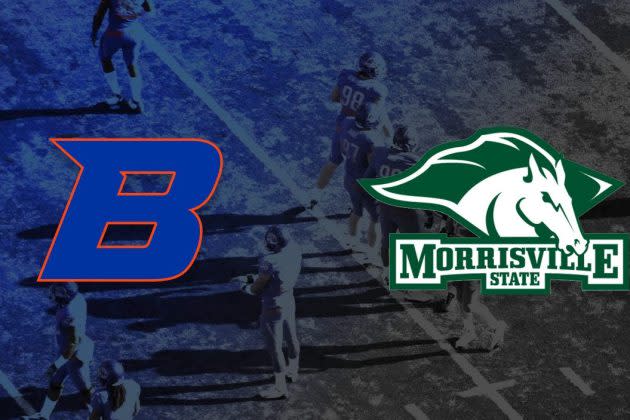Boise State’s Trademark Turf Tested by SUNY Morrisville Snub

Earlier this summer, SUNY Morrisville drew national attention to the Mustangs’ Division III football program when it replaced the playing surface of its home field with black, synthetic turf, part of what the school’s AD hailed as his program’s “bold, new direction.”
The total project, which included some other field-level improvements, cost the upstate New York university $1.28 million, according to a contract obtained by Sportico.
More from Sportico.com
By going emo, the school joined a handful of select college programs that have, over the last two decades, broken from the traditional gridiron greens, including Coastal Carolina, Eastern Washington, Eastern Michigan and Central Arkansas.
And yet, in joining the ranks of these non-verdant outliers, SUNY Morrisville went a step bolder by breaking a norm that has been dutifully conformed to by the other nonconformists: seeking permission from Boise State University, which, in 1986, became the first university to implement a non-traditional athletic field color with its now-famous, blue “smurf turf.”
Why does this matter?
Well, in 2008, Boise State filed for a federal trademark of its football stadium’s famous “Smurf Turf,” which it was granted a few years later. Though the mark specifically refers to use of “the color blue,” Boise State has also asserted that it owns “long-standing common-law trademark rights” for the use of “any non-green playing field in connection with an intercollegiate sporting event or exhibition.”
Whether intentionally or not, SUNY Morrisville has now forced the issue. (The school’s AD and spokespeople did not respond to repeated questions and requests for comments.)
“While Boise State has not yet opted to enforce its famous and registered blue turf trademark against any non-blue turf or other non-blue usage,” Brad Frazer, BSU’s outside trademark attorney, told Sportico in a statement, “a determination as to whether a non-blue usage rises to the level of trademark infringement requiring a license, enforcement or both is a case-by-case determination.”
Frazer continued: “Thus, it is an overstatement to say that Boise State claims a trademark right to all non-green playing surfaces, but it is true that if correct facts arose, a non-blue usage might be seen as actionable as infringing our famous color mark.”
Frazer did not specifically address whether or not he believed SUNY Morrisville had laid the predicate with its black synthetic fibers.
Though the reach of its trademark claim has never been adjudicated, Boise State has successfully established the precedent that any institution wanting to lay down alternatively colored artificial grass on their athletic fields best first get the Broncos’ blessing. And so the fealty has been honored:
In 2009, the University of New Haven struck a non-monetary agreement with Boise State that granted UNH a non-exclusive license for the use of blue on its blue-and-yellow football field. (In 2020, the parties re-upped their agreement through 2030.)
In 2011, Boise State provided Central Arkansas a royalty-free license for a purple-and-gray turf, and Eastern Washington a license for its red turf.
In 2014, Eastern Michigan requested and was granted permission to install gray turf at Rynearson Stadium, and Coastal Carolina got the sign-off to deck Benton Field in teal.
For the latter, Coastal Carolina and Boise State executed a six-page licensing agreement, signed by CCU’s president, granting it the right to use teal (specifically: Pantone color PMS 322) on its field, so long as Coastal Carolina agreed “not to use the color blue as an indicator of origin.” Furthermore, the deal stipulated, the teal portion of Coastal Carolina’s Brooks Stadium could not exceed 75% of the field dimension.
There’s more: Coastal Carolina is forbidden from referring to itself as “the school with blue turf,” “the school with teal turf,” or the “sister school of Boise State”—if that was ever in the offing.
Though Boise State only claims to have trademark rights in the intercollegiate realm, a number of high schools have also sought its sign-off.
On July 31, Boise State’s trademark licensing and enforcement division provided written consent for Jordan High School in Long Beach, Calif., to install a blue football field, so long as it is “not shared with a university.”
Over the past two years, records obtained by Sportico show, similar agreements have been entered into with azure-fielded high schools in California, Florida, New Jersey and Michigan.
Last November, a junior baseball player at Highlands Ranch High School in Colorado personally sent an email request to Boise State’s trademark licensing and enforcement department.
“We are going to replace our turf field next year and I am trying to get a gray field instead of the boring traditional green field,” the high-schooler wrote. “I have been told the first step to my goal is getting approval from Boise State, as you have a federal trademark on any field color other than green.”
When a Boise State licensing staffer followed up with a request for a mock-up or drawing of the proposed field, the student submitted his own image, since the high school had not actually gone forward with the plan.
For whatever it was worth, Boise State eventually confirmed it had no objections, and expressed its appreciation that he had done obeisance first.
But not so for the Mustangs of SUNY Morrisville, whose “bold, new direction” in athletic aesthetics includes, as for now, bucking the Broncos.
Best of Sportico.com
